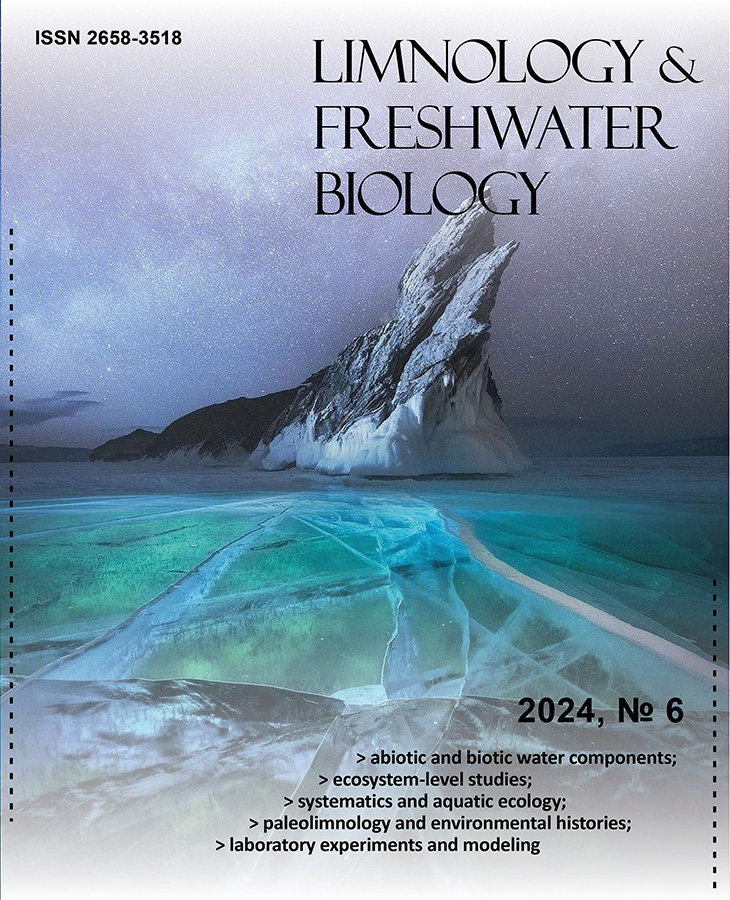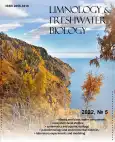No 5 (2022)
Articles
Industrial site of out-of-operation Baikalsk Pulp and Paper Mill as a potential source of pollution in Lake Baikal coastal zone
Abstract
The Baikalsk Pulp and Paper Mill (BPPM) was functioning on the shore of Lake Baikal for almost 50 years. These years of operation inevitably imposed specific adverse effects on the lake ecosystem. Finally, the BPPM was closed in 2013 but with no measures to mothball the plant. During 2013–2016, we observed a few atypical phenomena through our complex investigations of the coastal zone area next to the BPPM. Water temperature measurements, hydrochemical analysis, and FTIR spectroscopy showed these phenomena as unusual for Lake Baikal’s pristine coastal areas. (1) We noted an anomalously high temperature of the interstitial water of the beach next to the BPPM. The water from the hole on the beach reached a temperature of 25 °C in June 2013. (2) The hydrochemical parameters of the water from the beach were analyzed, and the interstitial water there exhibited an appreciably lower concentration of oxygen and higher content of sulfur, sodium, and chlorine comparing the lake’s water. (3) We discovered the specific black depositions to cover the stones of the target beach. The IR spectrum of those depositions was found to be identical to the BPPM sludge-lignin. All these observations and results of chemical analyses point out that the industrial site of the nonfunctioning plant is still a substantial source of pollution, which negatively influences the Southern Baikal coastal zone ecosystem.
 1630-1638
1630-1638


Comparative analysis and reconstruction of phylogenetic position of sunbleak Leucaspius delineatus (Heckel, 1843) from the Irkutsk Reservoir
Abstract
This work was aimed to a comparative analysis and reconstruction of the phylogenetic position of sunbleak Leucaspius delineatus (Heckel, 1843) from the Irkutsk Reservoir. Determination of a species specific fragment of the Cox1 gene allowed to reveal a unique common haplotype present in all specimens analyzed. Comparative analysis and phylogenetic reconstruction based on nucleotide sequences available in genetic databases showed that the studied species is represented by three phylogenetic lineages. Intraspecific differences of nucleotide sequences of fragments of the Cox1 gene amounted to 5.5%, and within phylogenetic lineages - < 3%. The studied fishes were related to the genetic lineage widely distributed in Europe and northwestern Russia. It is shown that all specimens with 100% genetic similarity belong to the same genotype, which is due to recent introduction of sunbleak into Pre-Baikal and to the “founder effect”.
 1639-1642
1639-1642


Movies about diatoms and their movements
Abstract
Diatoms are unique unicellular photosynthetic organisms that have siliceous frustules around their cell membrane. Diatom cells are capable of independent movements in the aquatic medium, which is important for their life strategy. This article summarizes my main observations on the movements of diatoms, including some hypotheses. The material is presented in the form of six video films.
 1643-1644
1643-1644


Copepod cryptic species as aquatic invaders
Abstract
The dispersal of aquatic organisms has especially increased since the 19th century, mainly due to the introduction of metal ships with ballast compartments or with birds. Along with easily visible aquatic organisms, there are invasions of less noticeable aquatic organisms, like copepods, which can mainly be recognized by experts. A special group is made up of cryptic species for which morphological identification is inaccessible or very difficult. This review is devoted to the identification, description and analysis of the dispersal routes of three copepod cryptic species complexes into waterbodies. Using molecular-genetic methods, Eurytemora carolleeae introduction were revealed in 2007. After describing this invader as a new species, its distribution was also studied using morphology. The invasions of Acanthocyclops americanus and Eurytemora caspica were mainly studied using morphological methods since the species have already been described; however, molecular-genetic methods were also used to confirm their distinctions from local forms. The real distribution of the former “cosmopolitan” species Eucyclops serrulatus was studied using a multidisciplinary approach that combined molecular-genetic, cross-hybridization and morphological methods. Judging by the distribution of local E. serrulatus sensu stricto populations in coastal waterbodies of most continents, this species can apparently serve as a good marker of the species dispersal processes with ships. The three possible scenarios resulting from cryptic species introductions and their interaction with local fauna were competitive displacement (A. americanus), competitive coexistence (E. carrolleeae) and independent development without competition (E. serrulatus). The role of cryptic species invasion in aquatic biodiversity modification is discussed.
 1645-1655
1645-1655


Substrates for cell cultivation based on thermosensitive imidazole copolymers
Abstract
Cell cultures are needed in various fields: the study of cell structure and function, models in drug screening, and other biomedical applications. Most tissue-derived cells can only grow on solid substrates. Thus, cell culturing involves three steps: cell adhesion on the surface, cell growth and division on the surface, and cell detachment from the surface for further use. Thermo- and pH-sensitive polymers are promising substances for cell culture coatings. Changes in temperature and/or pH can drastically change surface properties, resulting in gentle cell detachment. We synthesized copolymers with pendant imidazole and hydrophobic groups that exhibit the properties of weak polymeric bases capable of thermosensitivity due to hydrophobic interactions. Plastic surface can easily be coated with copolymers by pouring over the copolymer solution. The modified plastic surface is a good substrate for culturing adenocarcinomic human alveolar epithelial cells. The cells show strong adhesion to the copolymer film and high viability after detachment under the influence of temperature and/or pH changes.
 1656-1662
1656-1662


Silica scaled Protista and Stomatocysts in East Siberia
Abstract
The review examines the work on biodiversity in the reservoirs of Eastern Siberia of a wide, but poorly studied group of organisms forming siliceous scales and bristles – these are scaled chrysophytes, chrysophycean stomatocysts and heterotrophic protists: rotosphaerids, colorless free-living thaumatomonad flagellates, centrohelid heliozoans. The difficulty in studying these objects is the need to use electron microscopy for their species identification. High biodiversity of silica scaled Protozoa has been revealed in the reservoirs of Eastern Siberia and the relationship of their species composition with the parameters of the aquatic environment, including in areas of local anthropogenic impact, has been shown. The recorded enrichment of the mouths of Arctic rivers with boreal species is important for predicting changes in aquatic ecosystems in the context of GCC. The proposed scenario of the settlement of siliceous chrysophytes at the beginning of the Holocene may be valid for other small planktonic organisms. The high degree of preservation of siliceous stomatocysts in sediments allows them to be used as an additional signal of changes in lake ecosystems in the past, this is based in particular on the reconstruction of the ecosystem and changes in the level of Lake Vorota (Yakutia) in the Holocene-Upper Pleistocene.
 1663-1670
1663-1670


The problem of species delimitation within the endemic Lake Baikal sponges Lubomirskiidae
Abstract
The delimitation of species within the endemic sponge family Lubomirskiidae is difficult. Along with specimens falling within the range of morphological variability of previously described specimens, we found specimens with intermediate morphological characteristics. The largest number of such specimens had intermediate characteristics between representatives of the genera Lubomirskia and Baikalospongia. For some species of these genera, a common feature is the structure of megasclera in the form of oxeas of a similar size. At the same time, the genera Swartschewskia and Rezinkovia have less variable morphological characteristics, so the identification of species belonging to these genera based on morphology is not difficult. The results of our study indicate the need for delimitation of Lubomirskiidae species based on molecular data.
 1671-1674
1671-1674











